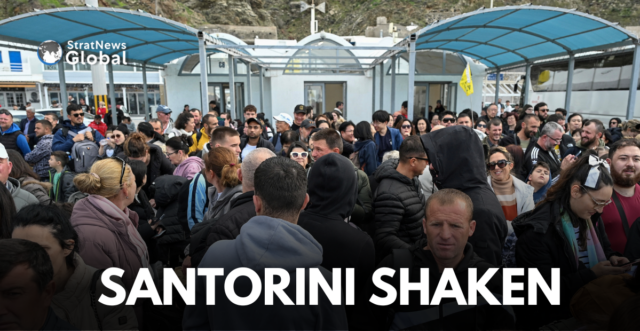Families boarded ferries and extra flights were laid on to help people leave Santorini on Monday as dozens of earthquake tremors shook the island in Greece for a fourth day.
Tremors have been recorded between the volcanic islands of Santorini and Amorgos in the Aegean Sea since Friday, forcing authorities to close schools in Santorini and nearby Ios, Amorgos, and Anafi until Friday.
Quakes, some with a magnitude above 4, rattled Santorini every few minutes on Monday as people were advised to stay out of indoor spaces and small ports. Disaster response units were deployed on the ground as a precaution.
Continuous Seismic Activity
Experts have said the seismic activity on the island, some of whose most populated areas are perched on steep cliffs, will continue for weeks.
Local officials said that permanent residents were not particularly worried as they have been used to quakes but some who were on the island, a popular holiday destination, for work were moving out.
“For three days now there have been earthquakes all the time, every five minutes, it is continuous they don’t stop at all, the entire island is traumatized,” said Tzanis Lignos, 35, who managed to find tickets for himself, his wife and his son to leave.
“No one could sleep last night, not my wife. There was a lot of noise. We went running outside, that is why we cannot stay here any longer.”
Many rushed to board the ferry on Monday including families with babies and children.
“There are constant earthquakes, it is intense, we feel it,” said Zoi Lignou, 72.
“We have been patient for three days but today was the worst so we said we will leave, for as many days as it takes.”
Volcanic Activity
Aegean Airlines said it would operate three additional flights to and from Santorini on Monday and Tuesday to facilitate the travel of residents and visitors upon a request by Greece’s Civil Protection Ministry.
“We estimate it (the activity) will continue for some days and there could be a lengthy seismic sequence,” Efthymios Lekkas, a professor of tectonic geology and disaster management, and part of a team of experts assessing the situation on the ground, told Greek television.
Greece sits on multiple fault lines and is often rattled by earthquakes.
One of the largest volcanic eruptions in history, around 1600 BC, formed Santorini in its current shape. The last eruption in the area occurred in 1950.
Experts said a mild volcanic activity also recorded near Santorini in recent days was not linked to the quakes.
(with inputs from Reuters)





